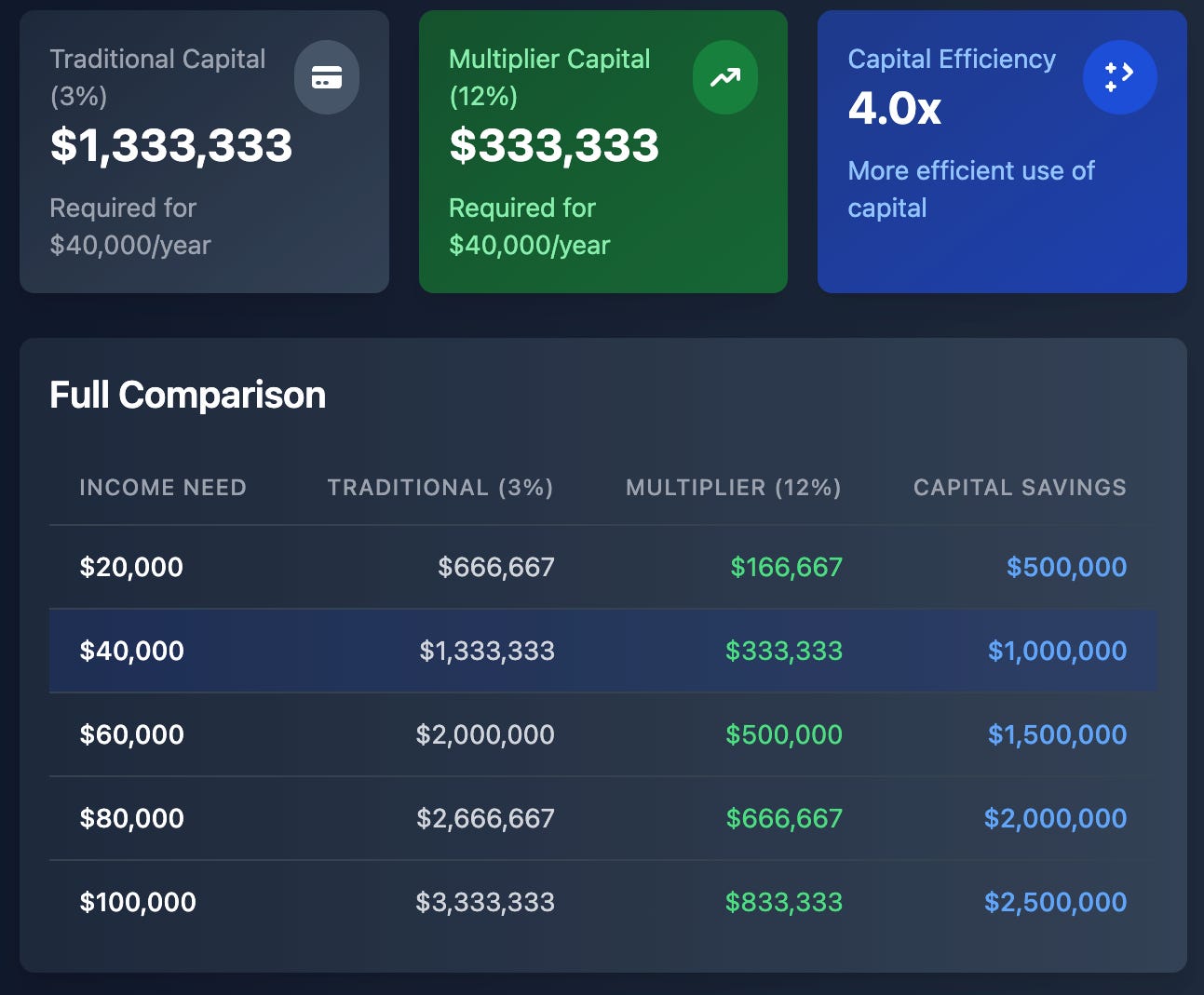"How much money do I need to have to feel comfortable in retirement?"
You're asking the wrong question.
The real question and the only one that matters is: “What income stream will support my lifestyle, and how do I build it?"
The financial industry keeps peddling the 4% rule like it's gospel.
For those who need a refresher: it suggests you can withdraw 4% of your retirement nest egg in the first year, adjust for inflation annually, and your money should last 30 years.
Sounds simple, right?
It's also spectacularly flawed.
Four Fatal Flaws of the 4% Rule
1. Rigid Formula, Fluid Life
Retirement isn't linear, but the 4% rule is.
Early years bring travel costs; later years bring medical bills. Social Security timing varies. Other income fluctuates.
Yet this approach forces you to maintain the same withdrawal rate regardless of changing circumstances.
Result — you're constantly second-guessing whether you can afford that family vacation or home renovation that would actually improve your life.
2. Sequence of Returns: The Retirement Killer
Retire into a bear market and you're forced to sell assets at depressed prices just to keep the lights on.
Each withdrawal during downturns permanently damages your portfolio's recovery potential.
The 1966 retiree cohort learned this lesson the hard way when their carefully calculated plans collapsed during a decade of stagflation and market turmoil.
The 4% rule turns market timing into a retirement lottery.
3. The Wealth Preservation Paradox
After decades of saving discipline, the 4% rule often creates excessive conservatism.
You scrimp and sacrifice only to die with a fortune unspent.
What's the point of retirement planning?
Building the biggest estate possible, or actually enjoying the rewards of your labor? Are you planning to live or planning to leave an inheritance?
4. The Longevity Blindspot
The 4% framework was built around a 30-year retirement horizon.
With modern medicine, many of us will need 35-45 years of funding. Early retirees need even more.
This simplistic model offers no guidance for increasing lifespans and ignores the fundamental uncertainty of how long your money actually needs to last.
Your financial plan needs to outlive you, not the other way around.
So, what happens when we apply the 4% rule to real-world numbers?
The math gets sobering quickly:
Median 401(k) balance, ages 60-69: $210,724
Monthly income from 4% rule: $702
Average Social Security benefit: $1,909
Total monthly income: $2,611
Typical monthly expenses: $5,000
Monthly shortfall: $2,389
Even Morningstar's latest research suggests safe withdrawal rates are dropping to 3.7-3.8%, making the gap even worse.
Stop obsessing over how much you need to accumulate.
Start focusing on how much you need to generate.
To understand the difference, consider two retirees:
Scenario A: The Lump Sum Hoarder.
You hit retirement with $2 million. Great! But every month, you withdraw $5,000. That $2 million becomes $1.995 million, then $1.990 million, and so on. Every market dip feels like a personal attack. You're constantly watching the balance shrink, wondering if you'll outlive it. The "comfort" is fleeting, replaced by the anxiety of depletion.Scenario B: The Income Machine Operator.
You have a portfolio that, regardless of its current market value, is reliably spitting out $5,500 in income every month, and that income is growing by 5% per year. Your expenses are $5,000. You're not just covering your needs; you have a surplus. The market can wobble, but your paychecks keep rolling in, and they're getting fatter. You're not depleting capital; you're generating it.
This is true comfort. This is financial freedom.
One is a race against time and inflation; the other is a perpetual motion machine.
Redefining the Retirement Number.
Your retirement target shouldn’t be a lump sum, but rather an income stream.
Step 1: Define Your Ideal Lifestyle
What annual income would make retirement comfortable? Include travel, hobbies, healthcare, and occasional splurges. Be realistic but don't shortchange yourself—this is the life you've worked decades to create.
Step 2: Identify Guaranteed Income Sources
Tally your Social Security benefits, pension payments, and any other reliable income streams that will continue regardless of market conditions.
Step 3: Calculate Your Income Gap
This simple equation reveals your true retirement number:
Desired Annual Income - Guaranteed Income = Portfolio Income TargetIn a typical scenario:
Desired lifestyle: $75,000/year
Social Security (couple): $40,000/year
Income gap: $35,000/year
This $35,000 annual income requirement—not some arbitrary million-dollar portfolio value—is your actual retirement target.
It's a dynamic cash flow objective, not a static account balance.
Once you've identified your income target, how do you build a system to deliver it?
Enter the Multiplier Loop
This approach fundamentally rewires your retirement thinking.
Instead of watching a dwindling balance with growing anxiety, you're managing an appreciating income stream with increasing confidence.
The framework stands on four strategic pillars:
Dividend Growth stocks that increase payouts annually
High-Yield investments that maximize current income
Buffett-Style Value positions for capital preservation
Options Income strategies that extract premiums regularly
The individual components matter less than how they function together—creating multiple, reinforcing income streams that compound over time.
If you are a new reader, I explain this investing philosophy in depth here:
It's a paradigm shift that changes everything about how you approach retirement.
Generating Your Target Income
How does this system produce the income you need year after year? — By integrating multiple income streams into a single reinforcing engine.
The Multiplier Loop's true power comes from its compounding momentum:
OWN quality dividend growers → SELL covered calls/CSPs → REINVEST every premium into more shares → REPEAT
Each income stream feeds back into acquiring more income-producing assets.
Your initial income target isn't the ceiling—it's the foundation.
As premiums and dividends get reinvested, your income curve accelerates upward year after year.
This is an autonomous income machine that works tirelessly, generating paychecks that outpace both inflation and your expenses.
Traditional vs. Income-Focused Approaches
For a $35,000 annual income target:
Traditional approach: $1,166,667 needed ($35,000 ÷ 3%)
Income-focused approach: $291,667 needed ($35,000 ÷ 12%)
That's a difference of $875,000—a sum that represents a vacation home, decades of travel, or a substantial legacy.
Market Crash Protection
Traditional retirement planning is particularly vulnerable during market downturns.
What happens when stocks plunge 30% just as you start withdrawals?
When you're forced to sell depreciated assets to fund expenses, you permanently damage your portfolio's recovery potential.
The income-focused alternative offers crucial protection. Quality dividend growers typically maintain or increase their payouts during market turbulence.
Your income stream remains stable even when asset values decline.
This creates both financial and psychological resilience.
You're collecting consistent income rather than watching your principal evaporate with each withdrawal.
Portfolio Size Check: What you need to generate various income levels
Let's put real numbers to this concept.
Here's what you actually need to generate various income levels:
The income growth potential becomes even clearer over time:
The uncomfortable truth? No fixed pile of money will ever feel like enough.
Not when you're systematically depleting it month after month.
The alternative isn't just mathematically superior—it fundamentally changes your relationship with money.
When your focus shifts from "how much you have" to "how much you generate," retirement transforms from a countdown to a construction project.
The blueprints are right in front of you. The tools are available.
Wealth was never about what you accumulate. It's about what you construct that keeps working for you.
I'll be back tomorrow with specific cash-secured put setups for the Premium subscribers.
Thank you for tuning in today and supporting my work!
Mike Thornton, Ph.D.












